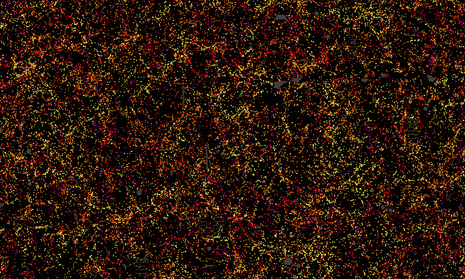It is hard to know whether it’s a success or a failure but modern astronomy tells us that almost three quarters of the universe is in the form of an unknown substance called “dark energy”.
Add to this the “dark matter” that astronomers are still searching for without success, and we think we live in a Universe where only two percent of it is the familiar atoms that make up you and I, stars and planets.
Worse still is the fact that no one has a clue about the true nature of the “dark energy” or how such a substance could come into existence. There is no hint of it in any known laboratory physics experiment. So whatever it is, the dark energy is too weak to be felt on small scales. Its effects are only visible when accumulated over billions of light years.
The latest attempt to gain insight into its nature was released on 14 July and presented as the largest map of the universe. It is more than just a pretty picture. Actually, it isn’t a pretty picture at all but it is an important next step in analysing the effects of dark energy on the universe.
The map was made by the Sloan Digital Sky Survey, which uses a 2.5metre-diameter telescope at Apache Point Observatory, New Mexico. The telescope has been making regular surveys since 2012 and is currently working in tandem with The Irénée du Pont Telescope at Las Campanas Observatory, Chile, to extend its observations to the southern hemisphere.
Five years in the making, the current map charts the positions and distances of 1.2 million galaxies across a volume of around 650 billion cubic light years. Each galaxy is home of a few hundred billion stars yet appears as a single dot on the map.
The key thing about the map is the pattern that the galaxies make. It can be used to reveal the effects of dark energy, which opposes gravity by pushing galaxies apart rather than pulling them together.
So, the distribution of galaxies across the universe is the result of the interplay between gravity and dark energy.
In particular, astronomers were looking for spherical ripples in the distribution called baryon acoustic oscillations (BAO). These were created by the equivalent of sound waves in the early Universe and then expanded by the interplay of gravity and dark energy.
Once they identified the ripples, astronomers then used computers to explain their current size by varying the amount of dark energy in the universe until their simulations looked like the real data.
This has been done by a number of groups all working independently around the world with hundreds of astronomers involved. Combining the results shows that the dark energy appears to be “cosmological constant” which suggests it is a constant energy field stretching throughout space.
But the question of what this energy actually is remains completely unanswered. There is no natural candidate in any known physics. As such, the nature of dark energy is the greatest challenge facing astronomers and physicists today. It promises a fundamental re-think of physics.
Its effects came to light only in 1998 when two independent studies showed that the expansion of the universe was accelerating. Expansion was expected because of the gigantic energy liberated during the big bang, the universe’s beginning almost 14 billion years ago, but the acceleration was a shock. Astronomers had expected that the initial expansion rate would now be slowing because of the effects of gravity.
Although there is an overwhelming majority of astronomers who believe in the existence of dark energy – and by extension a root and branch re-working of modern physics – some insist that there is a simpler answer.
To them, dark energy is the product of an oversimplification in the way we apply Einstein’s General Theory of Relativity to our study of the universe. In other words, we are getting the sums wrong, and then saying that the error must be the result of an previously undiscovered energy field.
To make their sums easier, astronomers assume that matter is spread evenly throughout space. Change this to reflect that the universe is “lumpy” – which is a much harder calculation – and the need for dark energy goes away, say the mavericks.
Who is right? Only time and an awful lot more work will tell.
To this end, the European Space Agency will launch the Euclid mission in 2020. It will map the shapes, positions and movements of two billion galaxies across more than a third of the sky, during the course of a six year mission. More than 1000 scientists from over 100 institutes across 14 European countries are working on the mission.
Once the data is in, the race will be on to see who can provide the most accurate simulation: the “dark energists”, or those who believe in the “lumpiverse”.
Stuart Clark is the author of The Unknown Universe (Head of Zeus), and co-host of the podcast The Stuniverse (Bingo Productions).

Comments (…)
Sign in or create your Guardian account to join the discussion